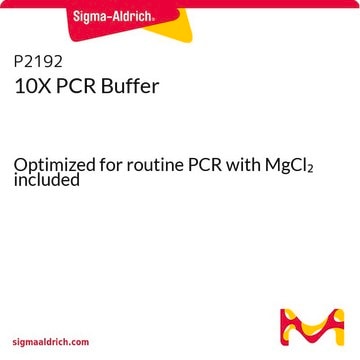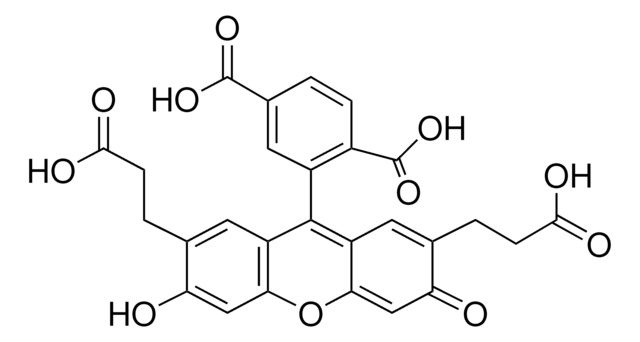MAK150
Fluorometric Intracellular pH Assay Kit
sufficient for 1000 fluorometric tests
Autenticatiper visualizzare i prezzi riservati alla tua organizzazione & contrattuali
About This Item
Codice UNSPSC:
12161503
NACRES:
NA.84
Prodotti consigliati
impiego
sufficient for 1000 fluorometric tests
Metodo di rivelazione
fluorometric
Malattie correlate
neurological disorders; genitourinary disorders; cancer
Temperatura di conservazione
−20°C
Descrizione generale
Intracellular pH changes are implicated in diverse physiological and pathological processes, including cell proliferation, apoptosis, fertilization, malignancy, multidrug resistance, ion transport, lysosomal storage disorders, and Alzheimer′s disease.
This kit can be utilized to measure decreases in intracellular pH in cells treated under various conditions using a simple standard protocol. Alternatively, an Acid-Load procedure can be used to measure the increase of intracellular pH associated with changes in cellular metabolism due to GPCR activation, growth factor activity, or other cellular stimulation. With the Acid-Load procedure ammonium chloride solution is added after the fluorescent pH dye is loaded into cells in a minimum volume. This Acid-Loading step is followed by the addition of agonist in a relatively large volume (~4x) of buffer. The sudden volume change initiates an efflux of ammonia (NH3) from the cells causing a rapid decrease in intracellular pH, and thus a decrease in fluorescence signal. The effect of agonist on the subsequent recovery of intracellular pH is measured by the relative fluorescence signal increase.
This kit can be utilized to measure decreases in intracellular pH in cells treated under various conditions using a simple standard protocol. Alternatively, an Acid-Load procedure can be used to measure the increase of intracellular pH associated with changes in cellular metabolism due to GPCR activation, growth factor activity, or other cellular stimulation. With the Acid-Load procedure ammonium chloride solution is added after the fluorescent pH dye is loaded into cells in a minimum volume. This Acid-Loading step is followed by the addition of agonist in a relatively large volume (~4x) of buffer. The sudden volume change initiates an efflux of ammonia (NH3) from the cells causing a rapid decrease in intracellular pH, and thus a decrease in fluorescence signal. The effect of agonist on the subsequent recovery of intracellular pH is measured by the relative fluorescence signal increase.
Applicazioni
Fluorometric Intracellular pH Assay Kit has been used to measure the intracellular pH.
Caratteristiche e vantaggi
Superior alternative to BCECF
Compatibilità
This kit can be utilized to measure changes in intracellular pH in cells treated under various conditions.
Principio
The Fluorometric Intracellular pH Assay Kit utilizes a proprietary cell-permeable fluorescent indicator, BCFL-AM, for measuring relative intracellular pH changes. BCFL-AM is a superior alternative to the popular ratiometric pH probe, 2′,7′-bis-(2-carboxyethyl)-5(6)-carboxyfluorescein (BCECF). Unlike BCECF, which is a complex and variable mixture of isomers, BCFL-AM is a single isomer species. BCFL-AM has the same spectral responses as BCECF-AM (λex = 490 nm/λem = 535 nm for single measurement or λex = 505 nm/λem = 535 nm and λex = 430 nm/λem = 535 nm for ratio measurement) but enhanced reproducibility. BCFL-AM exhibits pH-dependent dual excitability, pKa ~7.0, and an excitation isosbestic point of 454 nm.
Codice della classe di stoccaggio
10 - Combustible liquids
Classe di pericolosità dell'acqua (WGK)
WGK 3
Punto d’infiammabilità (°F)
Not applicable
Punto d’infiammabilità (°C)
Not applicable
Certificati d'analisi (COA)
Cerca il Certificati d'analisi (COA) digitando il numero di lotto/batch corrispondente. I numeri di lotto o di batch sono stampati sull'etichetta dei prodotti dopo la parola ‘Lotto’ o ‘Batch’.
Possiedi già questo prodotto?
I documenti relativi ai prodotti acquistati recentemente sono disponibili nell’Archivio dei documenti.
I clienti hanno visto anche
Selective inhibition of carbonic anhydrase-IX by sulphonamide derivatives induces pH and reactive oxygen species-mediated apoptosis in cervical cancer HeLa cells.
Koyuncu I, et al.
Journal of Enzyme Inhibition and Medicinal Chemistry, 33(1), 1137-1149 (2018)
Shawn C Chafe et al.
Science advances, 7(35) (2021-08-29)
The metabolic mechanisms involved in the survival of tumor cells within the hypoxic niche remain unclear. We carried out a synthetic lethal CRISPR screen to identify survival mechanisms governed by the tumor hypoxia-induced pH regulator carbonic anhydrase IX (CAIX). We
Besa Emini Veseli et al.
FEBS letters, 594(18), 3067-3075 (2020-07-04)
6-Phosphofructo-2-kinase/fructose-2,6-bisphosphatase isoform 3 (PFKFB3) is a key enzyme of the glycolytic pathway, and it plays an essential role in angiogenesis. 3-(3-Pyridinyl)-1-(4-pyridinyl)-2-propen-1-one (3PO) is frequently used as a glycolysis inhibitor and is thought to inhibit PFKFB3. However, this latter effect of
Shawn C Chafe et al.
Cancer immunology research, 7(7), 1064-1078 (2019-05-16)
Treatment strategies involving immune-checkpoint blockade (ICB) have significantly improved survival for a subset of patients across a broad spectrum of advanced solid cancers. Despite this, considerable room for improving response rates remains. The tumor microenvironment (TME) is a hurdle to
Il team dei nostri ricercatori vanta grande esperienza in tutte le aree della ricerca quali Life Science, scienza dei materiali, sintesi chimica, cromatografia, discipline analitiche, ecc..
Contatta l'Assistenza Tecnica.









